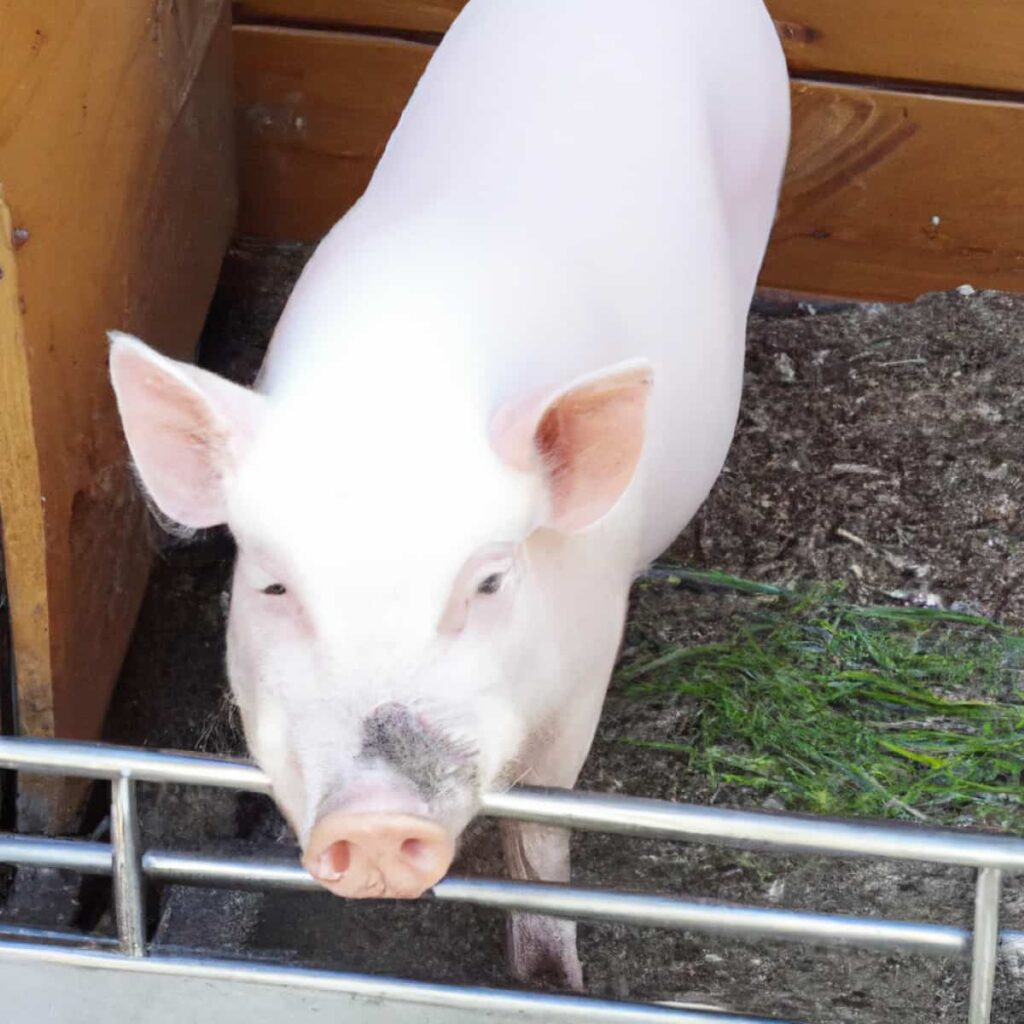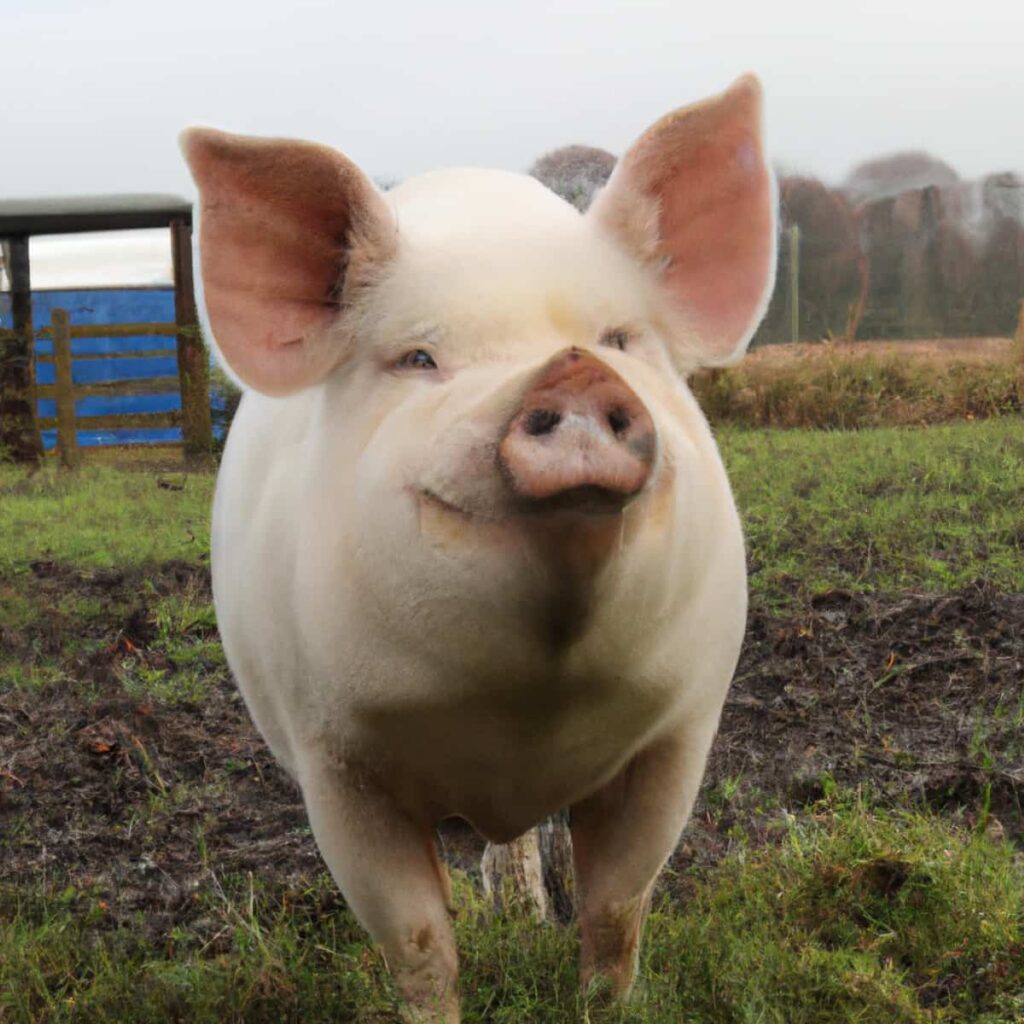Chester White pigs are a domestic swine breed originating from Chester County, Pennsylvania, in the United States. They are known for their solid white color, durable skin, and medium-sized ears that droop forward. This breed is highly valued for its maternal abilities, obedience, and carcass quality.

Chester Whites were developed in the early 1800s and have since become popular for their adaptability to various climates and conditions. They are known for their excellent feed conversion rates and are often used in crossbreeding programs to improve the qualities of other pig breeds.
History
- The Chester White pig, also known as the Chester County White, originated in Pennsylvania between 1815 and 1818.
- Bred from large white pigs in the US and white boars from England by an unknown breeder.
- Formation of the Chester White Swine Records Association in 1913 through the merger of two existing associations.
Physical Characteristics
- Recognizable by its white color, smooth skin, and short white hair.
- Features a large head and face with expressive eyes, medium-sized ears, a wide neck, and muscular shoulders.
- Medium-sized legs provide excellent support, a straight back, and a moderate-width loin.
- Adults have 44 teeth covered in enamel, with piglets replacing teeth by 12 months.
- Six functional teats per side for both boar and gilt, with a long, twisted tail.
- Medium to large size, with males larger than females.
Lifespan and Growth
- Lifespan ranges from 6 to 10 years, with rapid growth reaching market weight at 5 to 6 months.
- Sexual maturity at seven months for gilts; males weigh up to 900 lbs, females up to 700 lbs.
Temperament and Behavior
- Generally calm and docile but may show aggression if mistreated.
- Friendly and cooperative with proper handling, sociable with other animals.
- Enjoy grazing and investigating their environment.
Meat Characteristics
- Used widely in commercial pork production for its high-quality meat.
- High intramuscular fat and pH values result in tender, juicy meat suitable for various cuts.
- Flavor varies with diet and living conditions, versatile for cooking methods.
Raising Chester White Pigs
- Feeding includes grains, vegetables, fruits, nuts, dairy, and forage; ample clean water is essential.
- Adaptable to various environments, including pasture or confinement systems.
- Thrive in temperate climates, need shelter and wallow for hot weather.
Breeding and Health
- Breeding involves natural or artificial insemination, with sexual maturity at seven months.
- Litter size of 8 to 10 piglets, gestation period of 113 days.
- Vaccination against common pig diseases is crucial for health maintenance.
Advantages and Disadvantages
- Advantages include fast growth, efficient feed conversion, large litter size, and high meat quality.
- Disadvantages include susceptibility to obesity and heat stress, skin issues, and potential aggression if mishandled.
Profitability and Personal Use
- Ideal for commercial farms due to rapid growth and high meat yield.
- Suitable for homesteaders seeking a large meat yield for personal use.
- Versatile in culinary applications, providing various pork products.
Housing and Environment
Housing Requirements
When raising Chester White pigs, suitable housing and environmental conditions are crucial for their well-being and productivity. Their housing should offer protection from extreme weather conditions, adequate space for movement, and proper ventilation to maintain air quality. Furthermore, it should be designed to facilitate efficient waste management and minimize the risk of injury to the pigs.
Environmental Considerations
Chester White pigs are well-adapted to various climates, but proper environmental management is essential for their welfare. Adequate shade, access to clean water, and protection from temperature extremes are vital considerations. Additionally, the design of the housing should allow for natural behaviors such as rooting and wallowing, which are inherent to pigs’ instincts.
Feeding and Nutrition
Nutritional Requirements
A well-balanced diet is essential for Chester White Pigs’ growth and development. Their nutritional needs depending on their age, weight, and reproductive status. A typical diet for growing pigs includes a mix of grains, protein sources, vitamins, and minerals to support their energy requirements and muscle development. Sows require specialized diets during gestation and lactation to support the health of both the mother and her piglets.
Feeding Management
Feeding management plays a crucial role in maximizing the potential of Chester White pigs. It involves formulating diets, establishing feeding schedules, and monitoring the pigs’ body condition to ensure they are receiving adequate nutrition. Additionally, access to clean water at all times is for maintaining proper hydration.
Health Management
Disease Prevention
Maintaining the health of Chester White pigs is paramount for successful pig farming. Disease prevention strategies include vaccination programs, biosecurity measures, and regular health monitoring. By implementing sound biosecurity protocols and working closely with veterinary professionals, farmers with minimize the risk of infectious diseases and promote their pigs’ overall well-being.
Parasite Control
Parasitic infestations can significantly threaten pig health and productivity. Implementing parasite control measures, such as deworming protocols and environmental management, is crucial for mitigating the impact of internal and external parasites on Chester White pigs.
Breeding and Genetics
Breeding Objectives
Selecting the right breeding stock is essential for achieving the desired traits in Chester White pigs. Breeders often focus on traits such as litter size, growth rate, carcass quality, and maternal abilities when making breeding decisions. By prioritizing these traits, farmers can enhance their herds’ genetic potential and improve overall productivity.
Genetic Improvement
Advancements in genetic technologies have enabled pig breeders to make significant strides in improving Chester White pigs’ genetic merit. Tools such as artificial insemination, genomic selection, and performance recording allow farmers to make informed breeding decisions and accelerate genetic progress within their herds.
Handling and Behavior
Behavioral Considerations
Understanding the behavior of Chester White pigs is crucial for effective handling and management. Pigs are social animals with complex behavioral patterns, and providing an enriching environment that allows for natural behaviors is key to their welfare.
Farrowing and Piglet Care
Farrowing Management
Farrowing, the process of giving birth to piglets, is the production cycle of Chester White pigs. Providing sows with a comfortable and safe farrowing environment is essential for ensuring successful deliveries and the well-being of both the mother and her piglets. Adequate nesting materials, proper heating, and close monitoring during farrowing are essential components of farrowing management.
Piglet Care
Careful attention to piglet management is crucial for ensuring the survival and growth of the newborn piglets. This includes ensuring that piglets receive colostrum shortly after birth to acquire passive immunity, monitoring their health and growth, and providing a conducive environment for their development. Additionally, early interventions such as tail docking and iron supplementation may be necessary to promote piglet welfare.
Growth and Weight Management
Growth Monitoring
Monitoring the growth of Chester White pigs is essential for assessing their development and adjusting management practices as needed. Regular weight measurements and growth rate assessments provide valuable insights into the effectiveness of feeding programs and overall herd health. Identifying and addressing growth challenges early can help optimize the performance of the pigs.
Weight Management
Achieving optimal weight gain is a key objective in pig farming. Proper nutrition, management practices, and environmental conditions play pivotal roles in supporting healthy weight gain in Chester White pigs. Balancing feed rations, providing access to clean water, and ensuring a stress-free environment are essential for promoting efficient growth and achieving desired market weights.
Marketing and Sales Strategies
Market Considerations
Understanding market trends, consumer preferences is vital for developing effective marketing and sales strategies for Chester White Pigs. Factors such as meat quality, production efficiency, and niche market opportunities can influence the positioning of Chester White pork products in the marketplace. Additionally, developing strong relationships with potential buyers and understanding the demands of the target market are crucial for successful sales.
Value-Added Products
Exploring value-added product options such as specialty cuts, processed pork products, and direct-to-consumer sales can enhance Chester White pork’s marketability. By diversifying product offerings and appealing to niche markets, farmers can capture additional value from their Chester White pig production.
In case you missed it: How to Start Sustainable Pig Farming: Business Plan, Benefits, and Requirements

Raising Chester White pigs offers a rewarding venture due to rapid growth, efficient feed conversion, and high meat quality. Despite challenges like susceptibility to obesity and heat stress, proper management ensures optimal growth and profitability, making them a valuable asset for commercial farms and homesteaders alike.
- Irrigation and Water Management in Pineapple Farming
- Blossom to Harvest: Mastering Flowering and Pollination in Papaya Farming
- Pig Fattening Essentials: From Selection to Sale for Beginners
- Raising Wagyu Cattle: A Complete Guide for Premium Beef Production
- Soil Types and Their Water Holding Capacity
- Optimizing Irrigation Schedules for Coconut Groves for Enhanced Yield
- Espresso Your Garden: Coffee Grounds for Healthier Acid-Loving Plants
- The Best Soil Mix for Snake Plants: How to Mix Your Own Snake Plant Soil
- Green Thumb Success: Expert Tips for Cultivating Greenhouse Beans All Year Round
